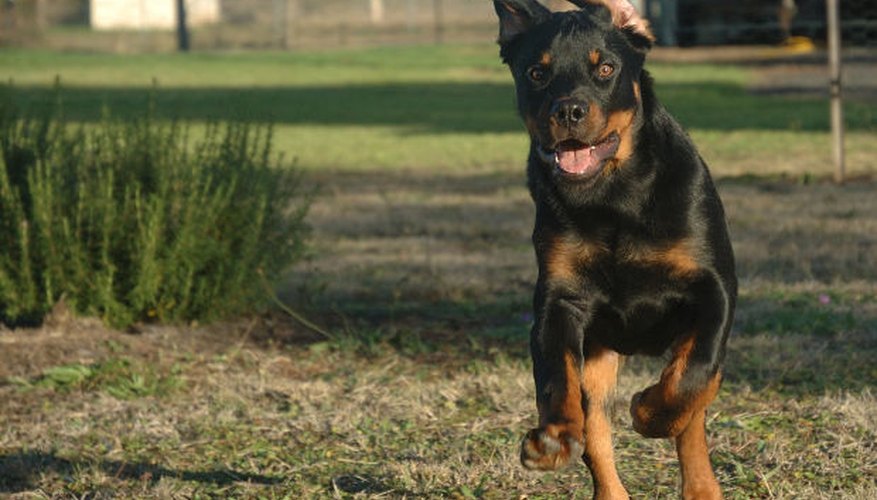Dog muzzles are used to inhibit the dog's ability to bite, chew, pick up trash during walks or vocalise. While they may be necessary when walking very aggressive dogs in public places or as a tool to inhibit a dog's destructiveness when left alone in a house, there are many muzzles that restrict a dog's ability to pant, drink, bark or sniff. There are several alternatives to muzzling your dog.
Collars
An effective alternative to muzzling your dog includes the use of a correction collar, which effectively inhibits a dog's ability to fight by removing the slack in a loop-style collar with a quick upward motion that causes the loop to tighten around the dog's neck and inhibits his movement.
Prong collars are made of metal links that have barbed prongs on the inside of the collar, so when the collar is snapped tight by the trainer, the dog feels a correction much like the sensation of teeth around his neck--the way a mother dog gives a warning bite to her pup to correct its behaviour.
Remote collars, also known as "electric" collars, work by delivering a mild shock to a dog's neck whenever he is being corrected.
Temperament
If you have chosen not to muzzle your aggressive dog and are instead opting for a correction or other type of collar or basic obedience training, there are some things you should keep in mind when making your choice about which techniques will be most effective for your dog.
Dogs behave aggressively for many different reasons. Some dogs are acting out of anxiety or fear, and many methods of inhibiting your dog's aggression may add to their basic insecurity and create bigger problems with your dog's behaviour in the long run.
If your dog demonstrates fear aggression, stay away from prong collars or remote collars, which will only reinforce your dog's anxiety in the situations where he is acting aggressively.
- If you have chosen not to muzzle your aggressive dog and are instead opting for a correction or other type of collar or basic obedience training, there are some things you should keep in mind when making your choice about which techniques will be most effective for your dog.
- If your dog demonstrates fear aggression, stay away from prong collars or remote collars, which will only reinforce your dog's anxiety in the situations where he is acting aggressively.
Usually sexual aggression is evident in male dogs. If your dog exhibits sexual aggression, which leads to conflict with other humans or dogs, using a prong collar or correction collar may be helpful, and obedience training is a must.
Obedience training, coupled with intensive behaviour modification exercises, is the only effective means of addressing territorial of aggression. Correction collars will only confuse your dog, who is attempting to protect the pack and is acting under the influence of an inborn instinct to do so.
Dominant aggressive dogs should be trained to do a job, such as carrying something in its mouth when walking. A prong collar will irritate him, as he feels what seem to be teeth on his neck at just the time he is deciding how to behave toward another dog. Training collars may inhibit his ability to tug and get into a fight but will only frustrate your dog's urges and may perhaps increase his desire to pull and fight. Remote collar corrections will be perceived as an attack and may cause your dog to lash out further.
Obedience Training
Depending on the type of aggression your dog exhibits, he may respond to basic training techniques to teach him alternative ways to behave in social circumstances. Teaching your dog to obey basic commands, such as, "sit," "leave it," "stay," or "drop it," may be enough to control his aggressive impulses when he is in uncomfortable social situations--such as meeting other dogs, cats or children while on walks.
Medication
If your dog's aggression is caused by an anxiety disorder or other type of psychosis, he may benefit from psychotropic medication, including anti-anxiety medication, antidepressants, antipsychotics or mood stabilisers. Just like humans, dogs may have physiological disorders of the brain which cause them to act erratically.
Sometimes aggression in dogs is caused by other physical conditions or illnesses, such as thyroid dysfunction, pain, epilepsy hypoglycaemia and diabetes. Any dog exhibiting aggression on a regular basis should receive a thorough physical check-up by a veterinarian to rule out physical causes before undertaking other types of aggression training or correction.
- If your dog's aggression is caused by an anxiety disorder or other type of psychosis, he may benefit from psychotropic medication, including anti-anxiety medication, antidepressants, antipsychotics or mood stabilisers.
- Sometimes aggression in dogs is caused by other physical conditions or illnesses, such as thyroid dysfunction, pain, epilepsy hypoglycaemia and diabetes.
Warnings
Not all training methods or collars work for every dog, and it may become necessary to use a muzzle to ensure the safety of other dogs and people that come into contact with your dog.
- Not all training methods or collars work for every dog, and it may become necessary to use a muzzle to ensure the safety of other dogs and people that come into contact with your dog.
If you choose to use a prong or other training collar, always remove it before your dog plays with another dog, as dogs will use their teeth around another dog's neck in play and could get their teeth stuck in the collar, which would create a dangerous situation or cause a fight to break out between the two dogs.
Never use a training collar to tether your dog, as it could lead to strangulation. Also, he could easily get loose by relaxing the tension on the collar and slipping his neck out of the loop.
